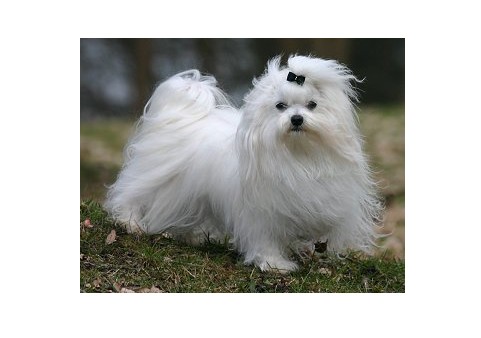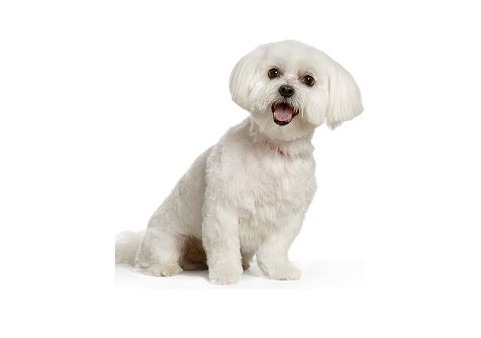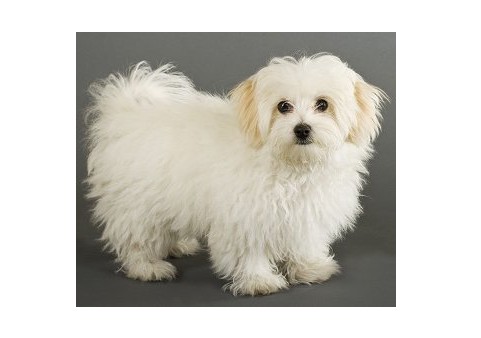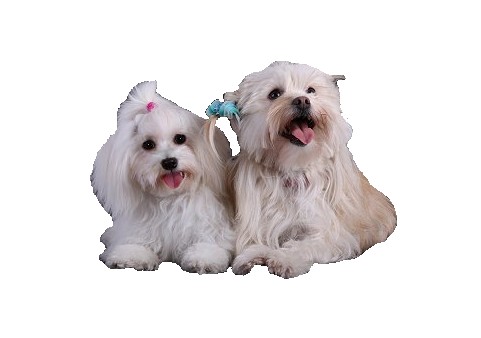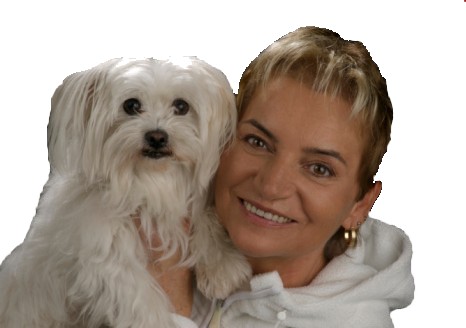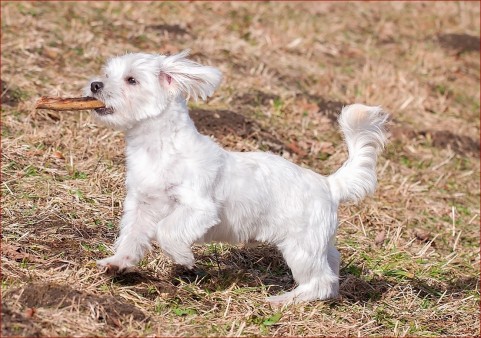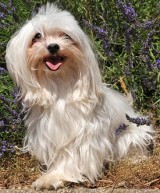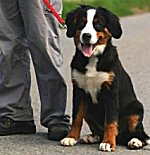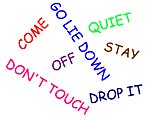Maltese: What's Good About 'Em, What's Bad About 'Em
Maltese temperament, personality, training, behavior, pros and cons, advice, and information, by Michele Welton, Dog Trainer, Behavioral Consultant, Author of 15 Dog Books
Jump directly to:
| Temperament | Lively, playful, peaceful, responsive.... |
| Pros and Cons | What's good... What's bad... |
| Size | Tiny (7-8 inches, 4-12 lbs) |
| Exercise | Minimal |
| Training | Good, except hard to housebreak |
| With strangers | May be friendly or standoffish |
| With children | 9 years and older – no small children |
| With other pets | Usually very good |
| Shedding | Very light |
| Grooming | Significant (either brushing/combing/trimming or clipping the coat short) |
| Lifespan | 12-15 years |
| Colors | White |
| Puppies | Easy to find |
| Rescue dogs | Easy to find |
| Similar breeds | Bichon Frise, Havanese, Coton de Tulear, Bolognese, Lowchen |
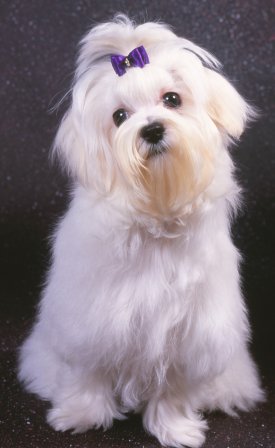
Not a big fan of the bow... I prefer to trim facial hair.
My experience with Maltese temperament
On the Mediterranean island of Malta, the Maltese was developed to be the household pet of wealthy, cultured families.
One of the brightest, sweetest, and gentlest of the toys, the Maltese is exceedingly playful and enjoys games of cleverness and dexterity such as "pull the hidden toy from under the cabinet with your paw.... then push it back under again!"
This curious, quick-moving sprite doesn't need much outdoor exercise, but he does enjoy dashing around your (fenced!) yard and accompanying you for walks.
Larger dogs may view him as a delicacy, so a Maltese must always be leashed or fenced for his own protection. Fences should be triple-checked for slight gaps, which would be fine for larger dogs, but through which a Maltese might wriggle.
Maltese are generally peaceful with the world, meaning they are not naturally dominant or aggressive. Some are more confident and friendly, others are more cautious or standoffish.
The general temperament of your Maltese depends to some extent upon genetics – outgoing parents tend to produce outgoing youngsters.
But along with the genes he inherited, how you raise your Maltese will also play a large factor in how he turns out.
As a behavioral consultant, when I'm seeing a "problem" Maltese, almost invariably the dog has been spoiled (over-indulged). His owner (1) has not taught the dog commands; (2) laughs at naughty behavior; (3) makes excuses for bad behavior; and (4) cuddles and "soothes" and "coos" over the dog too much. Far too much. Your Maltese is much more likely to end up anxious and insecure (or bratty and yappy) if you treat him like an infant or a stuffed toy.
Spoiling is a dreadful way to raise a dog; all it does is make the owner feel good, while creating an insecure dog who barks manically whenever he sees something that looks or sounds unfamiliar. What an awful state of mind for a dog to live with.
All dogs, whatever their size, should be taught how to walk on their own four feet, how to do what they're told, and how to get along peacefully with the world. This creates a confident, stable Maltese.
Now, you do need to take precautions! There are indeed dangers lurking everywhere for toy dogs. The trick is to let your Maltese walk on his own as much as possible, while still keeping an eagle eye out for real danger.
If you don't protect his safety, he can be hurt or killed, but if you baby him and don't require him to be well-behaved, he can end up insecure or downright nasty
The good news is that Maltese are very sensitive and responsive to training. In fact, a good number of Maltese excel in competitive obedience and agility.
The bad news is.... Unfortunately the same cannot be said of house training. The vast majority of Maltese do not excel at housebreaking.
Yes, sad to say, this fun-loving little breed is notoriously difficult to housebreak. Consider an indoor litterbox, or a doggy door leading outside to a small covered potty yard.
Finally, Maltese are prone to separation anxiety when left home too long by themselves.
More than most other breeds, Maltese need a great deal of companionship and do not like being left alone for more than a few hours. They tend to express their anxiety and unhappiness through destructive chewing and barking.
Pros and cons of Maltese
The Good
- One of the smallest breeds – easy to pick up (and easy to pick up after)
- Lively, funny, playful, affectionate
- Usually peaceful with strangers and other animals
- Sheds very lightly (often a good choice for allergy sufferers)
- LOVES warm sunny weather
- Usually lives a long time
The Bad
- Physically fragile, requiring a great deal of supervision and monitoring
- The fine line you need to walk with toy breeds, where you need to protect their safety, yet require them to stand on their own four feet and be well-behaved
- "Separation anxiety" (destructiveness and yapping) when left alone too much
- Notorious housebreaking difficulties
- Frequent brushing/combing/trimming, or else regularly shearing the coat short (which looks really cute!)
 |
Dog Breed Traits – Which Traits Are Right For You? In this brand new series, I'll help you decide which dog breed traits would best suit you and your family, your home and yard, and your lifestyle, so you can choose the best dog breed for your family. |
Keep in mind that the inheritance of temperament is less predictable than the inheritance of physical traits such as size or shedding. Temperament and behavior are also shaped by raising and training.
FREE eBooks by Michele Welton
![]() "Respect Training for Puppies" and "Teach Your Dog 100 English Words" are free step by step guides to teaching your pup to be calm and well-behaved.
"Respect Training for Puppies" and "Teach Your Dog 100 English Words" are free step by step guides to teaching your pup to be calm and well-behaved.
![]() "11 Things You Must Do Right To Keep Your Dog Healthy and Happy" is a free guide to keeping your dog mentally, physically, and emotionally happy and healthy so you can enjoy a longer lifetime of companionship.
"11 Things You Must Do Right To Keep Your Dog Healthy and Happy" is a free guide to keeping your dog mentally, physically, and emotionally happy and healthy so you can enjoy a longer lifetime of companionship.

- You can avoid some negative traits by choosing an ADULT dog from an animal shelter or rescue group. With an adult dog, you can easily see what you're getting, and plenty of adult Maltese have already proven themselves not to have negative characteristics.
- If you want a puppy, you can avoid some negative traits by choosing the right breeder and the right puppy.
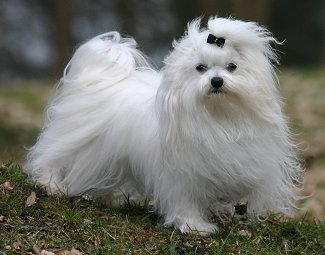
Lots of grooming required if you leave the coat long like this!
How big are Maltese?
According to the official breed clubs, Maltese are "supposed" to stand about 7-8 inches at the shoulder and weigh 4-7 lbs. But many individuals are smaller than 4 lbs (not good for overall health) and many individuals are larger than 7 lbs (safer, sturdier family pets).
Teacup Maltese? Tiny Toy? Micro Mini?
You might have heard those phrases associated with Maltese. For example, a breeder might tell you that "Toy" Maltese are a certain weight range, "Tiny Toy" Maltese are slightly smaller, "Extreme Tiny" Chihuahuas are smaller than that, etc. These breeders might even price their dogs according to weight, as if that should define a dog's value. And their prices are typically ridiculous.
Theses phrases are made-up marketing fluff, coined by savvy breeders who know that these cutesy phrases attract (gullible) buyers. Most of these breeders are irresponsible and their prices are typically ridiculous.
There is only one Maltese breed. There are no weight classes. Whether an individual weighs 2 pounds or 6 pounds or 10 pounds, he's still just a Maltese. Some individuals are simply smaller or larger than others.
Unfortunately, Maltese under 4 pounds are higher risks when it comes to health. Their bones are fragile. There is not enough room in their mouth for healthy teeth. Their internal organs are often weak and can fail suddenly. They tend to have difficulty regulating their blood sugar and can suddenly fall into hypoglycemic (low blood sugar) comas that can be fatal.
Responsible Maltese breeders never try to produce these tiny high-risk creatures. If a tiny one pops up in one of their litters, they do their best to find the best home that can keep it alive, yes, but they try hard not to produce them in the first place.
IRRESONSIBLE breeders, on the other hand, deliberately breed tiny, high-risk Maltese, because they can sell them for high prices to unsuspecting owners. If you reward irresponsible breeders by giving them your money, you are encouraging them to keep producing tiny, sickly, short-lived creatures.
Please be a responsible buyer and stick with Maltese who will mature at 4 pounds and up, who have the best chance of living a normal healthy life. In this way, breeders will be motivated to produce these sizes.
You can estimate whether a puppy will mature at 4 pounds and up by this guideline: if he already weighs at least 2 pounds at 10-12 weeks old, he should mature at over 4 pounds. It's not a perfect guideline, but it's usually close.
Look at the puppy's mother and father. If they're well over 4 pounds, their puppies are more likely to be, as well.
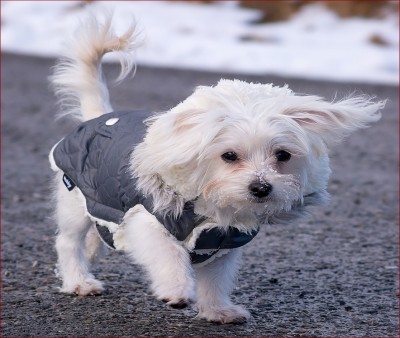
Now HERE is my kind of short clip for Maltese! Easy to keep clean and neat, and gives the dog lots of freedom running around in the Great Outdoors!
How much exercise do Maltese need?
Not much outdoor exercise, but that's because they're so lively indoors and get most of their exercise running around the house.
So if you have an apartment or condo with no fenced yard, is a Maltese a good choice?
Well... honestly, I don't like to recommend any dog if you can't provide a safe fenced area so they can stretch their legs and run around a bit or do to the bathroom – off-leash.You might be wondering if it would be okay to let your Maltese off-leash in that nicy grassy area beside your driveway. I would never do that – there are far too many dangers lurking for a dog of this size.
Along with physical exercise, your Maltese will appreciatemental exercise, where the dog gets to participate in interesting activities that keep his mind stimulated.
This might be a dog sport such as agility, rally obedience, or musical freestyle. It might be interactive dog toys, or a homemade obstacle course, or learning tricks, or playing games such as Hide 'n Seek.
Some of these activities are included in my free online training book, Teach Your Dog 100 English Words.
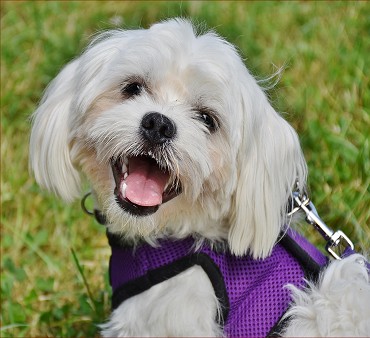
Another neat and clean "look" for a Maltese
Are Maltese easy to train?
Ah, that depends on what you want to teach them!
- It's very easy to train a Maltese to do tricks and play games.
- It's easy to teach a Maltese to be well-behaved and follow your household's rules and routines.
- It can be a little more difficult to teach a Maltese to be quiet. All toy breeds can be quite noisy – it's a defense mechanism given their vulnerable size. Nonetheless, barking can easily get out of control. You must teach your Maltese not to bark excessively and to stop barking immediately when you tell him to. But this only works if you establish the right relationship between you and your Maltese, where you are the leader and he is the follower.
- The hardest thing to teach most Maltese is housebreaking. As a behavioral consultant, I would put the Maltese on my Top 5 List of Hardest Breeds to Housebreak.
If you live in a cold or rainy climate, housebreaking will be especially difficult, because Maltese hate cold and wet.
- A COVERED potty area is strongly recommended.
- Sometimes a doggy door is necessary so your Maltese can run outside the moment he feels the urge in his tiny bladder.
- An indoor litterbox also works well for Maltese.
All of these housebreaking options are detailed in my free puppy training book, Respect Training For Puppies.
How sociable are Maltese?
Are they friendly with strangers?
Some Maltese are extremely friendly, while others are more standoffish.
Either type will bark when someone comes to the door. Your job is to teach your Maltese that some initial barking is fine... but that the dog must stop barking when you take over and go to open the door. This will only happen when your dog views himself as the follower and you as the leader.
Are Maltese good with children?
I never recommend keeping a Maltese with children under the age of about 9, no matter how well-meaning the child.
Younger children cannot help being clumsy, and that a child "meant well" is little solace to a Maltese who has been accidentally stepped on, sat on, squeezed, hit with an errant ball, or dropped down the stairs or onto the concrete patio.
In addition, most Maltese feel overwhelmed by the loud voices and quick movements that children can't help making, and stress and fearfulness (even defensive biting) may be the result.
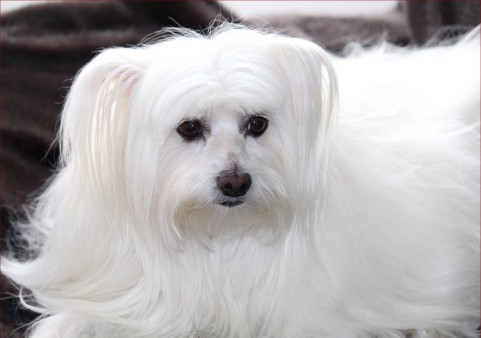
This coat length is required for a competition show dog, but it gets tangled and matted and dirty very quickly.
Are Maltese good with other pets?
Maltese are generally peaceful and get along great with other pets in their own family.
But you should be careful about mixing them with larger dogs. If you want to try this, be sure you can read dogs accurately, and be sure the other dog is quiet, gentle, and well behaved. A big bouncy dog can hurt a Maltese by accident.
I would not mix a Maltese with a breed whose heritage is chasing prey animals. Maltese can look like prey animals, especially when they move quickly. This can trigger instinctive chasing behavior in breeds such as medium to large terriers, sighthounds, herding breeds, and northern (spitz) breeds like Alaskan Malamutes and Akitas.
With strange dogs outside their own family, a Maltese might be friendly or not. Many toy breeds tend to pitch a fit when they spy a strange dog, especially a larger dog. Most likely they're blustering, trying to convince the larger dog that he needs to "move along" rather than having the toy dog for lunch.
This is an anxious state of mind for your little dog to live with. Better to teach him that you are the leader who will take charge of keeping other dogs away from him. Then he will be able to relax and leave everything up to you. That's the psychologically healthy and secure mind-set you want your dog to have.
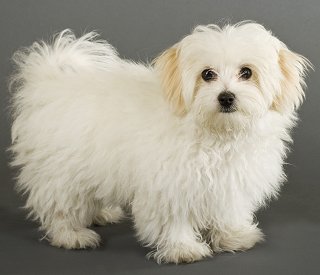
Maltese are great!
Grooming: do Maltese shed a lot? Are they easy to groom?
Maltese shed very little, but coat care is a major consideration with this breed. Without frequent brushing and combing and trimming, a Maltese becomes a matted mess.
The worst places for mats and tangles are behind the ears, in the armpits behind the front legs and the body, and on the chest, stomach, and groin. The legs and paws also need to be kept combed free of mats and tangles.
In addition, you should regularly clip around the dog's groin and anal area so they remain clean and sanitary when your little longhaired dog goes to the bathroom. Remember, anything that sticks to long hair (including waste!) eventually ends up on your furnishings.
Honestly, I recommend keeping a Maltese coat clipped short. You can do this yourself, or have a professional groomer do it. A sheared coat is more comfortable for the dog, it's always clean and sanitary, and it's so easy to brush and bathe. And it makes your Maltese look like an adorable puppy throughout his life!
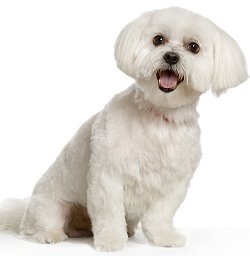
Gorgeous Maltese! And what a bright expression!
The only potential negative to a clipped coat is that some of the shed hair can more easily fall onto your floor and furniture. Whereas with the coat left long, the shed hairs get trapped by the long coat and only come out on your brush.
Either way, though, Maltese produce very little dander and are one of the few breeds tolerated by many allergy sufferers.
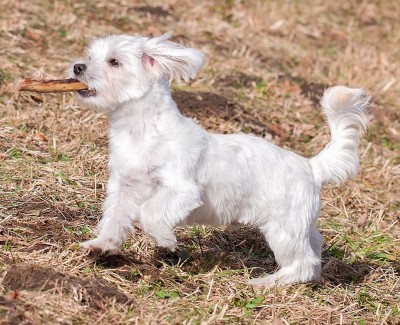
Sensible short trim lets a Maltese run and play without getting mats and tangles.
Are Maltese healthy? How long do they live?
Maltese typically live 12-15 years.
But whether they actually make it to that age depends largely on YOU.
Like many toy breeds, Maltese are more prone to injury than to disease. So whether a Maltese lives a long healthy life, or not, depends to a great extent on how careful you are to keep them safe.
Here are some of the injuries Maltese are vulnerable to:
- Being stepped on – good Maltese owners learn to shuffle their feet forward and backward rather than stepping up and down
- Choking on the tiniest objects – scan your floors frequently for anything that might have fallen
- Being conked on the head by a dropped, thrown, or falling object
Remember, a tiny creature can be seriously injured or killed by something that a bigger dog would barely feel.
- Leaping or falling from a high bed or high-backed sofa, or through the open slats of a stairwell landing or a raised deck
- Leaping from your arms. Some Maltese melt into your arms and stay there, but many are wriggly. They can be deceptive about it, too, apparently settling into your arms with contentment, then suddenly launching themselves through the air if you relax your grip. A fall from a few feet up, especially over a hard surface, can result in a broken leg or concussion. Hold on tight if you pick up a Maltese over concrete.
Children should not pick up this breed. If an older child is trustworthy and your Maltese is calm and wearing a harness and leash, you can place her in the child's arms, but keep the leash short and under control. It's safer if children sit on the ground to hold and play with a Maltese.
- Being accidentally jumped on by a larger dog
- Being seized and shaken by another dog
- Being grabbed by a great horned owl or an eagle (even a large hawk, if the Maltese is still a puppy)
Owning a toy breed means constant supervision and surveillance of what's going on around your tiny dog. Outside of their own fenced yard, Maltese should always be kept under leash or arm control. Too much can happen to these little guys in the blink of an eye.
Re: illness and diseases, Maltese are most prone to:
- dental disease – weak crooked teeth that form tartar as quickly as you can scrape it off; their mouth is too small to provide firm footing for healthy teeth
- luxating patella – loose knee joints, which can require expensive surgery
- chronic allergies that cause terribly itchy skin
- eye diseases that cause blindness
- collapsing trachea – a weak windpipe, resulting in chronic coughing
- liver shunt – a severe liver condition that requires tricky surgery
- heart diseases
- epilepsy/seizures
- eye diseases that cause blindness
Here is my complete list of health problems in Maltese.
See my advice on → keeping your Maltese healthy
(feeding, vaccinations, neutering, veterinarians, and more).
What colors do Maltese come in?
A Maltese is always solid white, or white with light tan or lemon shadings on his ears.
If you see someone advertising a "Maltese" as black or brown or any other non-white color, it's a crossbred Maltese, not a purebred Maltese. A crossbred means one of the pup's parents was a Maltese but the other parent was a different breed (one that comes in non-white).
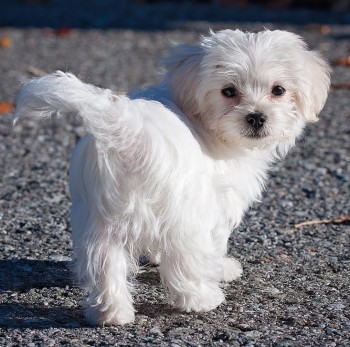
Oh my, what an adorable puppy!
Maltese Puppies
If you already have a Maltese puppy....
Congratulations! I'll be happy to show you how to raise and train your new family member.
- Follow my free puppy training program, Respect Training for Puppies: 30 seconds to a calm, polite, well-behaved puppy.
- Also see my advice on Maltese health care, including feeding and vaccinations
If you don't have a Maltese puppy, but you want one....
I can help you with that, too.
Maltese are very common and easy to find.
But first, are you really sure you want one? Are you sure you can provide what this breed needs?
- Someone home most of the day
- No young children
- No large, bouncy dogs in the household (safety issue)
- Extra safety precautions – ongoing supervision and surveillance of what's going on around your Maltese, being careful where you step or sit, not allowing leaps from high places, keeping small objects off the floor, blocking all slats and gaps in fences and railings, etc.
- An owner who will commit to crate training or litterbox training
- An owner who won't treat the dog like an infant or doll by carrying him everywhere, laughing at bad behavior and barking, and making excuses for bad behavior instead of correcting it
Or you can just hop onto Craigslist and buy a Maltese puppy from someone who "just breeds pets" or "just had one litter." But should you?
Not unless the seller has done the proper health certifications on the puppy's parents. One huge difference between a responsible breeder and an irresponsible "puppy producer" is – health certifications.
BOTH PARENTS of a Maltese puppy should have:
- a certificate from the Canine Eye Registry Foundation (CERF) – dated within the past year – certifying the dog to be free of eye diseases
- a certificate from the Orthopedic Foundation of America (OFA) or PennHip certifying the dog to have normal knees
If a seller can't show you those certificates, the puppies are higher risk for health problems. You might choose to accept that risk. But then you need to be willing (and able) to pay a couple thousand bucks for future surgeries and lifelong meds if your Maltese ends up with glaucoma or crippled joints.
See my advice on → finding a good dog
How do I adopt a Maltese?
Adopting From Dog Rescue Organizations
Maltese (and Maltese crosses and mixes) are frequently available from Dog Rescue groups. Maltese may be turned over to Rescue because their elderly owner died, or due to their significant grooming needs or housebreaking problems or barking or "separation anxiety" when left alone.
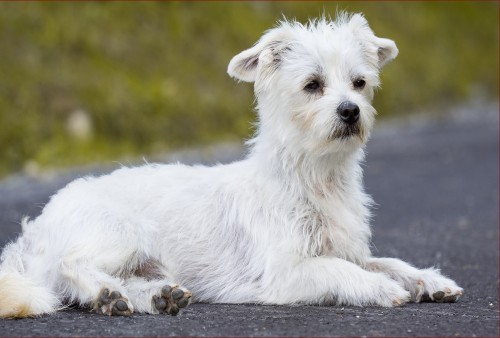
Adopting From Public Animal Shelters and Humane Societies
Maltese might sometimes be found here, although shelter personnel can be overzealous in labeling every small white longhaired dog as a "Maltese cross." Be aware that dogs can look like Maltese without having any Maltese genes at all.
What breeds are similar to Maltese?
The Maltese actually belongs to a "family" of related breeds. These kissing cousins are all similar in appearance and overall temperament.
They all need considerable coat care. They don't shed much. They make lively, playful companions. Unfortunately, they all tend to be slow to housebreak.
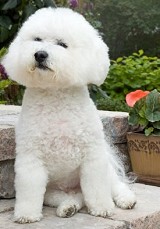
Bichon Frise (bee-shon free-ZAY)

Coton de Tulear (Ca-TONE duh TOO-lee-arr)
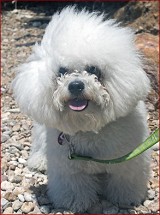
Bolognese (bo-lo-NEES)
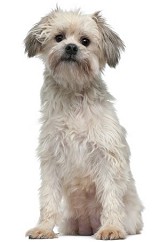
LOWCHEN (the LOW is pronounced as in allow)

The Yorkshire Terrier doesn't belong to the same family of breeds. But if you want a very small and light-shedding breed with more spunk than the breeds above, Yorkies are a nice blend of terrier and toy traits. You can clip the coat short for easy maintenance. Sadly though.... still very hard to housebreak!
My best-selling books – now available FREE on my website
 Respect Training For Puppies: 30 seconds to a calm, polite, well-behaved puppy is for puppies 2 to 18 months old. Your puppy will learn the 21 skills that all family dogs need to know. Click here to read for free.
Respect Training For Puppies: 30 seconds to a calm, polite, well-behaved puppy is for puppies 2 to 18 months old. Your puppy will learn the 21 skills that all family dogs need to know. Click here to read for free. Teach Your Dog 100 English Words is a unique Vocabulary and Respect Training Program that will teach your adult dog to listen to you and do what you say. Click here to read for free.
Teach Your Dog 100 English Words is a unique Vocabulary and Respect Training Program that will teach your adult dog to listen to you and do what you say. Click here to read for free. 11 Things You Must Do Right To Keep Your Dog Healthy and Happy helps your dog live a longer, healthier life. Get my honest advice about all 11 Things before you bring home your new puppy, because some mistakes with early health care cannot be undone. Click here to read for free.
11 Things You Must Do Right To Keep Your Dog Healthy and Happy helps your dog live a longer, healthier life. Get my honest advice about all 11 Things before you bring home your new puppy, because some mistakes with early health care cannot be undone. Click here to read for free.Related posts you might enjoy


